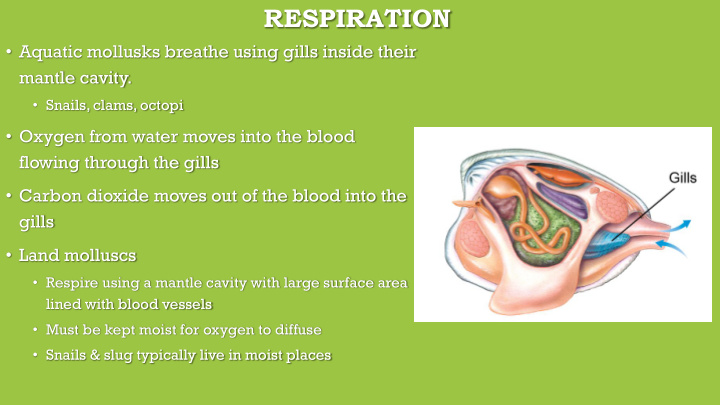



RESPIRATION • Aquatic mollusks breathe using gills inside their mantle cavity. • Snails, clams, octopi • Oxygen from water moves into the blood flowing through the gills • Carbon dioxide moves out of the blood into the gills • Land molluscs • Respire using a mantle cavity with large surface area lined with blood vessels • Must be kept moist for oxygen to diffuse • Snails & slug typically live in moist places
CIRCULATION • Oxygen and nutrients carried to all parts of the body via circulatory system • Open circulatory system, • blood is pumped through vessels by a simple heart • Blood eventually leaves the vessels and works it way through different sinuses • A large saclike space • Blood passes from the sinuses to the gills where gases are exchanged • Blood then returns to the heart
• Closed circulatory system • More efficient • Developed in fast moving mollusks • Transports blood quicker • Octopi & squid
EXCRETION • Cells of the body release cellular waste into blood • Nephridia remove ammonia from the blood and release it outside the body.
RESPONSE • Varies greatly • Clams and two shelled mollusks • Simple nervous system • Small ganglia near mouth • Few nerve cords • Simple sense organs (eyespots) • Octopi and relatives • Most highly developed nervous systems of all invertebrates • Well developed brains • Memory/intelligence • Active and intelligent predators • Release ink
MOVEMENT • Move in • Clam different ways • Scallop • Snails • Octopus • Secrete mucus • Snail on base of foot • Snail • Use rippling motion of foot • Fast moving molluscs • Jet propulsion
REPRODUCTION • Snails & two shelled molluscs • External fertilization (sexual) • Tentacled molluscs and certain snails • Internal fertilization (sexual) • Some species are hermaphrodites
Recommend
More recommend